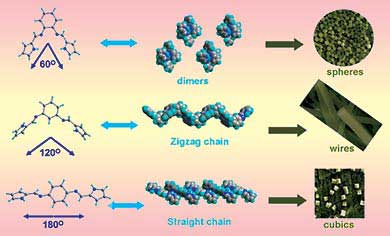| Posted: April 2, 2007 |
Rationally designed smart nanotechnology materials |
|
(Nanowerk News) Rationally designed smart nanotechnology materials could be a step closer thanks to Chinese chemists, who have revealed some of the subtle effects that control how nanostructures form ("Distinct nanostructures from isomeric molecules of bis(iminopyrrole) benzenes: effects of molecular structures on nanostructural morphologies").
|
|
Interactions that affect the way small molecules aggregate into a particular nanostructure have been revealed by Hongbing Fu, Jiannian Yao and colleagues at the Chinese Academy of Sciences in Beijing. A nanomaterial's properties are dictated by its structure, said Yao, but the ability to design small molecules that form nanostructures in a predictable manner is currently limited.
|
 |
| Bent molecules form nanospheres or nanowires, while straight ones make nanocubes. (Image: Chemical Science)
|
|
The Beijing team studied nanostructure formation using three isomeric starting molecules, each consisting of a central unit bearing two arms. The only difference between the isomers was angle of the arms; 60°, 120° or 180°. However, despite the small differences between them, the isomers formed very different structures: nanospheres, nanowires and nanocubes, respectively.
|
|
Yao puts the different structures down to the way the molecules initially cluster together into pre-aggregates. The 60° molecules dimerise, then clump to form nanospheres. However, the molecules whose arms were more open could form chains. The 120° molecules formed zigzag chains, which then meshed together into long wires. But the straight chains formed by the 180° material didn't mesh together as effectively as the zigzag chains, so gave cubes rather than wires.
|
|
'Researchers have prepared numerous nanoclusters, but many "beautiful" nanostructures were obtained serendipitously,' said Ben Zhong Tang, an advanced material synthesis expert at the Hong Kong University of Science and Technology. 'Fu and Yao have made a fundamentally important attempt to understand how the molecular structures of building blocks affect the morphological structures of their nanodimensional assemblies,' he said.
|
|
'We hope to unveil general strategies for creating well-defined supramolecular objects,' said Yao. 'Although tailor-made molecules can generally be obtained by organic synthesis, ensuring that the molecules aggregate in a specific way and generate nanostructures with desirable function remains a great challenge,' he said.
|

